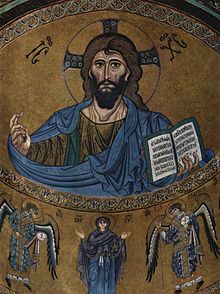Maria orans

The motif of Maria orans (lat. "Praying Maria"), Greek. Blacherniotissa (Βλαχερνιώτισσα) or Blachernitissa (Βλαχερνίτισσα) is in Christian iconography a certain type of Marie image and initially reported by three miraculous images in the Blachernae church in the district of Blachernae in Constantinople Opel back .
iconography
Mary orans, intercessor and mediator of the faithful becomes
- Standing frontally and praying with arms raised to the sides ( Orantenpose ) without baby Jesus or
- depicted with the full or half-length baby Jesus in the form of a breast medallion at the height of the abdomen ( platytera from the Greek platys "wide, wide").
- Another form of Blacherniotissa is the depiction of Mary with or without baby Jesus, flanked by saints and angels ( Panagia , Greek Παναγία "the most holy of holies").
After the iconoclastic turmoil, the pictorial form of Maria orans became an independent type, in late Byzantine times her place was in the apse under the pantocrator .
history
Aelia Eudocia , wife of the Eastern Roman emperor Theodosius II , is said to have brought relics to Constantinople from her pilgrimage to Jerusalem in 438/439 . Among them should have been a miraculous image, the veil (Maphorion) and the belt (zone) of the Blessed Mother, which Aelia Eudocia later sent to her sister-in-law Aelia Pulcheria .
After the death of Theodosius II in 450, his older sister Aelia Pulcheria had three churches dedicated to the Mother of God built in different parts of Constantinople. The third church Blachernae, let the Empress Pulcheria 452 on the land wall to the Golden Horn , one in the north to defend the city important point in the district Blachernae build to the dress of Mary and her towels, which one of their Dormition empty in Grave found to keep and venerate. There was also a Hodegetria and a Deesis in the church , which were given the nickname Blacherniotissa because they were in the Blachernenkirche.
The church burned down in 1433 and the icon of Maria orans, which was considered the original prototype, was destroyed.
The spread of the icon
Outside of Constantinople, especially north of the Alps, the Orans type has remained rare. The iconographic type of Maria orans is very old and can be found in the earliest depictions of the catacombs in Rome as early as the middle of the 3rd century. In the Priscilla catacombs in the “Cubicolo della Velata” (burial chamber of the veiled) one finds a woman in an oranten pose.
In the Basilica of Sant'Agnese fuori le mura there is a marble slab from the 4th century on which Saint Agnes is depicted in an ornamental pose.
In the 12th century, the image of the Blachernitissa Mother of God spread in Kiev and later in Yaroslavl .
Maria Orans in St. Sophia Cathedral in Kiev
See also
literature
- Lorenzo Ceolin: L'iconografia dell'immagine della madonna . Storia e Letteratura, Rome 2005, ISBN 88-8498-155-7 , p. 41 (Italian, online version (preview) in Google Book Search).
- Josef Strzygowski : Drei Miscellen: III, The Maria-Orans in the Byzantine art, in: Roman quarterly for Christian antiquity and church history . tape 7 , 1893, pp. 4-10 .
- Alfredo Tradigo: Icons and Saints of the Eastern Orthodox Church (Guide to Imagery) . Getty Trust Publications, Los Angeles 2008, ISBN 978-0-89236-845-7 , pp. 172 ff . (English, online version (preview) in the Google book search).
- Maria Vassilaki: Images of the Mother of God: Perceptions of the Theotokos in Byzantium . Routledge, 205, Picturing the spiritual protector: from Blachernitissa to Hodegetria, p. 209 ff . ( Online version (preview) in Google Book Search).
Web links
- Blacherniotissa. In: Rdklabor.de. Retrieved August 10, 2017 .
Individual evidence
- ↑ Blacherniotissa. In: Beyars.com. Retrieved July 30, 2017 .
- ^ Heinrich Schmidt, Margarethe Schmidt: The forgotten pictorial language of Christian art: a guide to understanding . CH Beck, Munich 2007, ISBN 978-3-406-54768-3 , pp. 204 ( online version (preview) in Google Book Search).
- ↑ Sercan Yandım: The icons from the museums in Antalya and Tokat in Turkey . VDM Verlag Dr. Müller, Saarbrücken 2008, p. 52 .
- ↑ Ingeborg Bauer, p. 70.
- ↑ Mary. Heiligenlexikon.de, accessed on June 9, 2017 (Italian).
- ↑ Rdklabor.de
- ↑ Lorenzo Ceolin, p. 41
- ↑ Lorenzo Ceolin, p. 39
- ↑ Alfredo Tradigo, p 172



